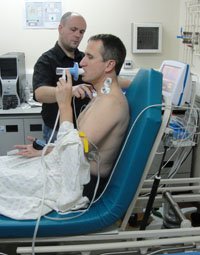
Identifying the “smell” of different types of lung bacteria could lead to a simple breath test to diagnose infections, a study on mice published in the Journal of Breath Research, suggests.
Breath analysis could reduce lung infection diagnosis times from weeks to minutes, the Vermont researchers said.
Scientists have already researched breath tests to diagnose asthma and cancer.
An expert said breath analysis was “an important and emerging field”.
Diagnosing bacterial infections traditionally means collecting a sample that is used to grow bacteria in the lab. This bacteria is then tested to classify it and see how it responds to antibiotics, which can take time.
Doctors see breath analysis, in contrast, as a fast and non-invasive method of diagnosing diseases.

For the study, researchers from the University of Vermont analyzed volatile organic compounds (VOCs) given off in exhaled breath by different bacteria as well as different strains of the same bacterium.
They infected mice with two bacteria that are both common in lung infections – Pseudomonas aeruginosa and Staphylococcus aureus – and sampled their breath after 24 hours.
The compounds in their breath were analyzed using a technique called secondary electrospray ionization mass spectrometry (SESI-MS), which is capable of detecting extremely small elements of the chemicals present in their breath.
The researchers said they found a “statistically significant” difference between the breath profiles of the mice infected with the bacteria and the mice that were uninfected.
They also said they were able to differentiate between two species of bacteria and two different strains of the same P. aeruginosa bacterium.
But Jane Hill, co-author of the study, from the University of Vermont College of Medicine, said there were still some challenges to overcome with “breath-prints”.
“We are now collaborating with colleagues to sample patients in order to demonstrate the strengths, as well as limitations, of breath analysis more comprehensively,” she said.